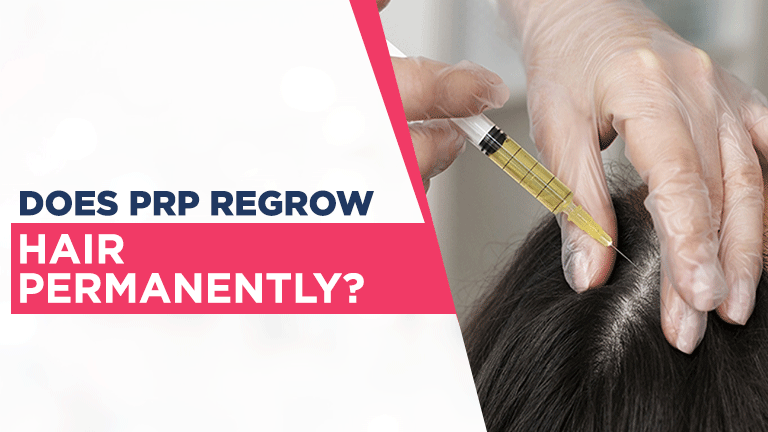
How long before the wedding should a bride get a HydraFacial?
All brides desire to have glowing, redless skin on the

A common treatment option for hair loss is PRP (Platelet-Rich Plasma) therapy. Many people ask, “Does PRP work for permanent hair regrowth?” Although PRP can greatly increase hair health and density, it is vital to understand that the effects might not always last.
In this blog, we’ll explore the PRP hair regrowth permanence and what you can expect.
PRP therapy, or Platelet-Rich Plasma therapy, is a treatment used to address hair loss. It involves using a concentrated form of platelets from your own blood to stimulate hair follicles and promote growth. The idea is to improve hair health and support new hair production.
Here’s how the process works:
PRP therapy works by injecting concentrated platelets into the scalp. Growth factors found in these platelets activate hair follicles. This stimulation encourages dormant hair follicles to become active and promotes new hair. growth. By enhancing blood flow and delivering vital nutrients to the hair follicles, PRP can improve hair health and thickness.
Most people see noticeable improvements in hair density and quality after several PRP sessions. Typically, results begin to show within 3 to 6 months. You may notice reduced hair thinning and an increase in hair volume as the therapy encourages healthier, thicker hair growth.
“PRP therapy often results in temporary hair regrowth,” is the right answer. While it can significantly boost hair growth, the effects are not always permanent. Many patients require ongoing treatments to maintain their results.”
Here are top 5 common myths about PRP for hair regrowth –
While PRP therapy can significantly boost hair density and stimulate growth, it does not offer a guaranteed, permanent solution for hair loss. Many patients see considerable improvement, but the effects may not last indefinitely. To maintain results, ongoing treatments are often necessary. It’s essential to manage expectations and understand that PRP is part of a broader hair restoration plan.
PRP therapy is not a one-time cure but rather a treatment that typically requires multiple sessions. A series of treatments is generally needed to achieve the best results, with follow-up sessions potentially required to sustain the benefits. The frequency and number of treatments depend on individual hair loss conditions and responses to therapy.
The efficacy of PRP therapy varies from patient to patient. While it can be beneficial for many, it does not work for everyone. The success of PRP depends on factors such as the underlying cause of hair loss and individual response to the treatment. Those with certain types of hair loss may experience more significant improvements compared to others.
PRP therapy is generally considered minimally invasive and safe. For the most part, patients are only slightly uncomfortable during the process. Since PRP uses a concentration of platelets from your own blood, the risk of allergic reactions or complications is minimal. The procedure is performed with sterile techniques to ensure safety.
Results from PRP therapy do not appear immediately. It usually takes several months to see noticeable improvements, with most patients observing changes within 3 to 6 months. The treatment stimulates hair follicles gradually, so patience is required to achieve the full benefits.
In summary, PRP therapy is a promising treatment for hair loss that uses your own blood to stimulate hair follicles and promote growth. While PRP can significantly improve hair density and health, it’s important to note that the results are often not permanent and may require ongoing treatments. The effectiveness of PRP varies depending on individual factors such as the type of hair loss and personal response to the treatment.
While PRP offers potential benefits, setting realistic expectations is crucial. It can provide noticeable improvements, but maintaining these results typically involves continued care and possibly additional sessions.
If you’re considering PRP therapy, consulting with a hair restoration specialist is a wise step. They can assess your specific situation, discuss your options, and help create a tailored treatment plan to meet your needs.

All brides desire to have glowing, redless skin on the
Dreaming of a sculpted body but struggling with stubborn fat
Struggling with severe hair loss or balding? At Clinic Eximus
Struggling with dull, tired skin? At Clinc Eximus , we
Struggling with hair thinning or excessive hair fall? At Clinic
Flawless skin isn’t just a dream—it’s a choice. Many turn